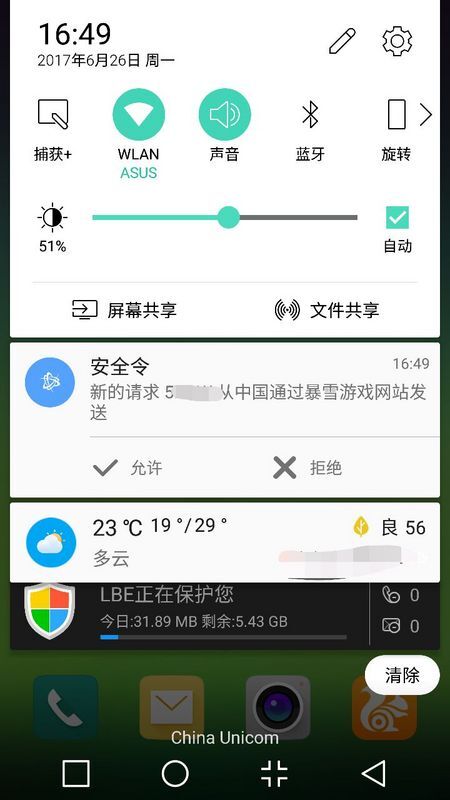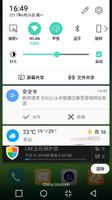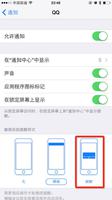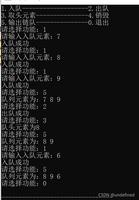【安卓】功能型消息推送功能如何实现(带同意 拒绝)

比如如上图的那种推送功能
现在哪些推送平台可以实现这种功能
回答
@erehmi 说的不错,根据厂商会有所不同。
给你举个原生android例子:
<?xml version="1.0" encoding="UTF-8"?> <LinearLayout xmlns:android="http://schemas.android.com/apk/res/android"
android:layout_width="fill_parent"
android:layout_height="fill_parent"
android:gravity="center"
android:orientation="horizontal" >
<TextView
android:id="@+id/textView1"
android:layout_width="wrap_content"
android:layout_height="wrap_content"
android:gravity="center"
android:text="DJ notification"
android:textAppearance="?android:attr/textAppearanceMedium" />
<Button
android:id="@+id/button1"
android:layout_width="wrap_content"
android:layout_height="wrap_content"
android:text="Close Me" />
</LinearLayout>
RemoteViews remoteViews = new RemoteViews(getPackageName(), R.layout.widget);
NotificationCompat.Builder mBuilder = new NotificationCompat.Builder(
this).setSmallIcon(R.drawable.ic_launcher).setContent(
remoteViews);
// Creates an explicit intent for an Activity in your app
Intent resultIntent = new Intent(this, test.class);
// The stack builder object will contain an artificial back stack for
// the
// started Activity.
// This ensures that navigating backward from the Activity leads out of
// your application to the Home screen.
TaskStackBuilder stackBuilder = TaskStackBuilder.create(this);
// Adds the back stack for the Intent (but not the Intent itself)
stackBuilder.addParentStack(test.class);
// Adds the Intent that starts the Activity to the top of the stack
stackBuilder.addNextIntent(resultIntent);
PendingIntent resultPendingIntent = stackBuilder.getPendingIntent(0,
PendingIntent.FLAG_UPDATE_CURRENT);
remoteViews.setOnClickPendingIntent(R.id.button1, resultPendingIntent);
NotificationManager mNotificationManager = (NotificationManager) getSystemService(Context.NOTIFICATION_SERVICE);
// mId allows you to update the notification later on.
mNotificationManager.notify(100, mBuilder.build());
推送一般分为两种:
推送通知
透传消息
推送通知一般是推送提供商帮你已经实现基本界面交互(包括收到通知后状态栏通知消息提醒, 通知点击行为), 这类是比较常用的. 而透传消息它只负责接收, 而不管前端展示, 这种消息正好能解决题主的需求: 客户端收到透传消息后, 自己编写代码弹出自定义样式的状态栏通知.
请参考各大推送厂商的SDK文档.
iOS在8.0之后就可以自定义推送信息显示按钮, 并且通过代理监听用户对推送消息操作.
1.在UIApplication中有对推送消息进行设置的方法
- (void)registerUserNotificationSettings:(UIUserNotificationSettings *)notificationSettings
2.UIUserNotificationSettings类中可以对消息添加用户行为(如: 按钮)
+ (instancetype)settingsForTypes:(UIUserNotificationType)types categories:(nullable NSSet<UIUserNotificationCategory *> *)categories;

3.添加UIUserNotificationAction,用于用户操作.
- (void)setActions:(nullable NSArray<UIUserNotificationAction *> *)actions forContext:(UIUserNotificationActionContext)context;![]()
推送截图:

代码:(参考链接)
[[UIApplication sharedApplication] registerForRemoteNotifications];UIMutableUserNotificationAction *actionAccept = [[UIMutableUserNotificationAction alloc] init];
actionAccept.identifier = @"accept";
[email protected]"√ 允许";
actionAccept.activationMode = UIUserNotificationActivationModeForeground;
actionAccept.destructive = YES;
UIMutableUserNotificationAction * actionReject = [[UIMutableUserNotificationAction alloc] init];
actionReject.identifier = @"reject";
[email protected]"× 拒绝";
actionReject.activationMode = UIUserNotificationActivationModeBackground;
actionReject.authenticationRequired = NO;
actionReject.destructive = NO;
UIMutableUserNotificationCategory *category = [[UIMutableUserNotificationCategory alloc] init];
category.identifier = @"Category";
[category setActions:@[actionReject,actionAccept] forContext:(UIUserNotificationActionContextDefault)];
UIUserNotificationSettings *uns = [UIUserNotificationSettings settingsForTypes:(UIUserNotificationTypeAlert|UIUserNotificationTypeBadge|UIUserNotificationTypeSound) categories:[NSSet setWithObjects: category, nil]];
[[UIApplication sharedApplication] registerUserNotificationSettings: uns];
使用自定义消息都可以做到。
题主说的这个是通知的样式,和推送关系不大。虽然推送通常也会带一个简单样式的默认通知,但是一般还是会使用自定义消息然后自己去定制通知的样式。
以上是 【安卓】功能型消息推送功能如何实现(带同意 拒绝) 的全部内容, 来源链接: utcz.com/a/97775.html







